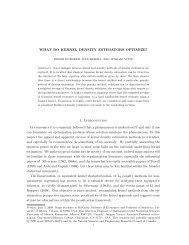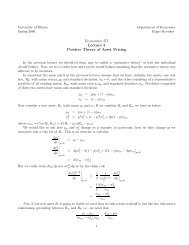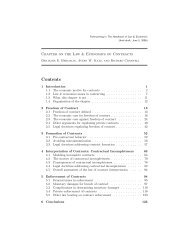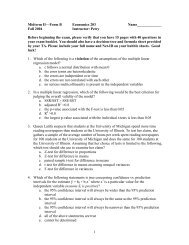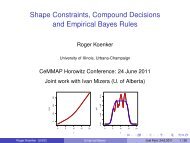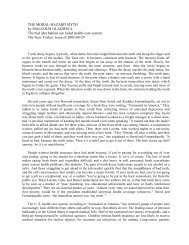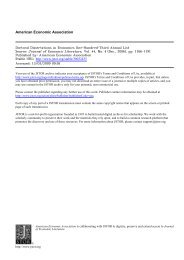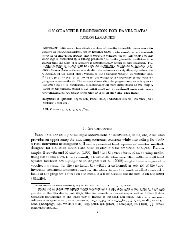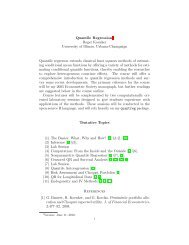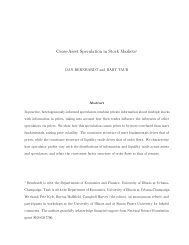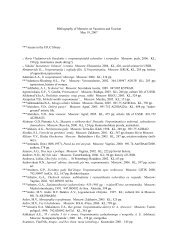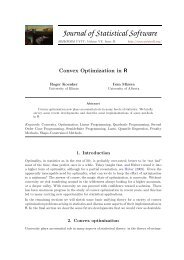1. Introduction - Econometrics at Illinois - University of Illinois at ...
1. Introduction - Econometrics at Illinois - University of Illinois at ...
1. Introduction - Econometrics at Illinois - University of Illinois at ...
Create successful ePaper yourself
Turn your PDF publications into a flip-book with our unique Google optimized e-Paper software.
Roger Koenker and Zhijie Xiao 5We can interpret the foregoing discussion in terms <strong>of</strong> the \potential outcomes"<strong>of</strong> the causal eects liter<strong>at</strong>ure. The Lehmann formul<strong>at</strong>ion essentially assumes th<strong>at</strong>the ranks <strong>of</strong> the control observ<strong>at</strong>ions would be preserved were they to be tre<strong>at</strong>ed.Heckman, Smith, and Clements (1997) consider a model which allows a specieddegree <strong>of</strong> \slippage" in the quantile ranks <strong>of</strong> the two distributions in the context <strong>of</strong> abounds analysis. Abadie, Angrist, and Imbens (1999) have suggested an IV estim<strong>at</strong>orfor quantile tre<strong>at</strong>ment eects when the tre<strong>at</strong>ment is endogonous. Oja (1981) considersorderings <strong>of</strong> distributions based on loc<strong>at</strong>ion, scale, skewness, kurtosis, etc., based onthe function (x).Of course, it is possible th<strong>at</strong> the two distributions dier only by a loc<strong>at</strong>ion shift, so() = 0 , or th<strong>at</strong> they dier by a scale shift so () = 1 F ,1 () or th<strong>at</strong> they dierby a loc<strong>at</strong>ion and scale shift so () = 0 + 1 F ,1 (): Indeed, most <strong>of</strong> the regressionliter<strong>at</strong>ure deals with just such models. These hypotheses are all nicely nested withinLehmann's general framework. And yet, as we shall see, testing them against thegeneral altern<strong>at</strong>ives represented by the Lehmann-Doksum quantile tre<strong>at</strong>ment eectposes some challenges. In the simplest context <strong>of</strong> the two sample tre<strong>at</strong>ment-controlmodel our tests may be viewed as quantile version <strong>of</strong> the conventional two-sampleKolmogorov-Smirnov testinwhich the null species th<strong>at</strong> the two distributions dierby the constant, 0 , in the case <strong>of</strong> the loc<strong>at</strong>ion shift, or by 0 + 1 F ,1 () for someunspecied distribution, F , in the case <strong>of</strong> the loc<strong>at</strong>ion-scale shift. The presenceunder the null <strong>of</strong> the unspecied parameters, 0 and 1 , or more precisely the need toestim<strong>at</strong>e them, disrupts the elegant asymptotically distribution free n<strong>at</strong>ure <strong>of</strong> thesetests and leads us to the Khmaladze transform<strong>at</strong>ion.2.2. Inference on the Quantile Regression Process. In the two-sample tre<strong>at</strong>mentcontrolmodel there are a multitude <strong>of</strong> tests designed to answer the question: \Isthe tre<strong>at</strong>ment eect signicant." The most familiar <strong>of</strong> these, like the two-sampleStudent-t and Mann-Whitney-Wilcoxon tests are designed to reveal loc<strong>at</strong>ion shift altern<strong>at</strong>ives.Others are designed for scale shift altern<strong>at</strong>ives. Still others, like the twosample Kolmogorov-Smirnov test, are intended to encompass omnibus non-parametricaltern<strong>at</strong>ives. When the non-parametric null is posed in a form free <strong>of</strong> nuisance parameterswe have an elegant distribution-free theory for a variety <strong>of</strong> tests, includingthe Kolmogorov-Smirnov test th<strong>at</strong> are based on the empirical distribution function.Non-parametric testing in the presence <strong>of</strong> nuisance parameters under the null, however,poses some new problems. Suppose, for example, th<strong>at</strong> we wishtotestthehypothesis th<strong>at</strong> the response distribution under the tre<strong>at</strong>ment, G, diers from thecontrol distribution, F ,by a pure loc<strong>at</strong>ion shift, th<strong>at</strong> is for all 2 [0; 1],G ,1 () =F ,1 ()+ 0for some real 0 ,orth<strong>at</strong>theydierby a loc<strong>at</strong>ion-scale shift, so,G ,1 () = 1 F ,1 ()+ 0 :



